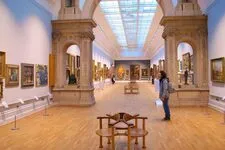A History of the French Cancan
Famous dance symbolizing the joys of the Belle Epoque, the French Cancan has turned many heads! Let's delve into the origins of this mythical step: the high kick and the flouncing frills.

The Beginnings of a Legendary Dance
In the early 19th century, the trend was for both public and private balls held in hotels, where the Parisian bourgeoisie of the Belle Epoque enjoyed gathering. It is in this context that the chahut or chahut-cancan first appeared, later known as the cancan or coincoin, a galop danced as a couple in balls and cabarets. During this time, women danced it in a very daring, even licentious manner, wearing long dresses revealing light petticoats and split bloomers. When their legs were lifted, the attire became highly erotic. Initially, the cancan was frowned upon by defenders of traditional morality, and the practice was limited to girls with so-called "loose" morals.
In 1850, Céleste Mogador, the star of the dance establishment Le bal Mabille, took hold of the "cancan" phenomenon and toned it down to spread its popularity. The resulting new dance lasted a little over ten minutes, during which women hopped and swayed in rows, side by side, facing the spectators, to fast-paced music. The frills of the long dresses were retained, but this time hiding closed drawers underneath. This morally more acceptable cancan by the authorities was then renamed the French cancan.
The must-see attractions in Paris




The Cancan Cabarets
Its popularity is also due to dancers such as La Goulue, a famous artist from the Moulin Rouge, who established the rules of the cancan as we know them today. But it was another great dancer from the Moulin, Nini Pattes en l'air, who, after 1894, became the first one to teach it. Thus, it is within the walls of the windmill on the hill of Montmartre that the French Cancan acquired its fame, which it has never lost since. The Moulin Rouge and its dancers continue to enchant its visitors to this day.
The French Cancan also shakes up the stage of another cabaret, that of the Paradis Latin, where the energetic dancers never fail to amaze you with their colorful performances! The acrobatics of the dancers mesmerize the spectators, and their flashy skirts make heads spin. Since April 2015, you can witness another French Cancan demonstration at the Lido de Paris.
As part of popular culture, the rules of the French Cancan are quite flexible and belong to all those who dance it. The versatility of the steps is also due to the fact that there is no school that teaches the cancan except for those of Grille d'Égout and Nini Pattes en l'air. However, some steps have remained the same for all, such as the famous leg movement in the air, with all frills raised!
That sexy French touch...
The French Cancan swiftly made its way across the Channel thanks to the English impresario Charles Morton, who wished to expose his countrymen to the more liberated attitudes of the French. The English and American audiences of the time quickly took the new dance to their hearts. For them it represented the joyous excesses of the City of Light as well as the sense of happy liberation that was so characteristic of the Belle Epoque. Today the cancan still evokes the image of a frivolous and festive Paris in which pleasure, fun and freedom are highlighted. The cancan was also an early harbinger of female liberation and empowerment, because in this dance it’s definitely the lady who leads!








